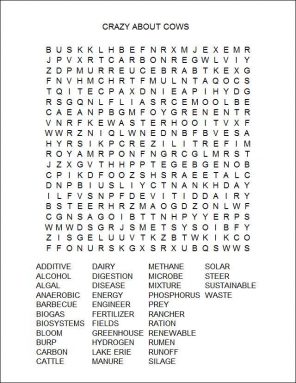Cool Jobs: Crazy about cows
Researchers work to make cattle healthier — and herds more environmentally friendly
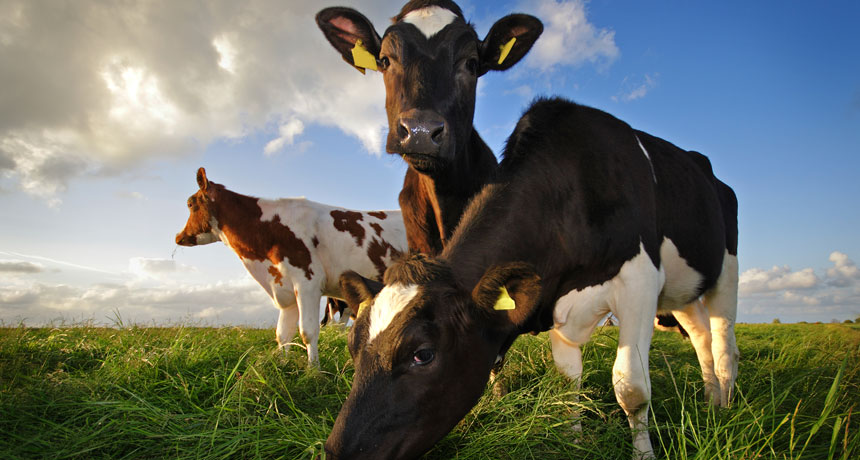
Cows provide milk, meat and other foods — plus lots of opportunities for important work in science and engineering.
boogje/ iStockphoto
Without cows, our diets would look very different. We’d go without hamburgers, grilled cheese sandwiches and barbecue beef. We wouldn’t melt butter on pancakes or put milk in our cereal.
There would be no ice cream.
Until the 1850s, most American families had their own cows. Now, most people live some distance from their nation’s 9.3 million dairy cows and 90 million beef cattle. So shoppers buy beef and dairy foods at a supermarket, and don’t give much thought to how cows are raised and managed. But there are many scientists and engineers who make these animals the focus of their lives.
And that’s fortunate because it can be a challenge to keep large herds of cattle healthy. Those animals also present an environmental challenge. Farmers and ranchers often aren’t equipped to study the gases and wastes that their animals produce, or to know how best to keep those wastes from harming the environment.
Here we meet three researchers who are working to ensure that dairy cows and beef cattle stay healthy and pose as little harm to the planet as possible.
Spotting the sick
“I always thought I wanted to be a cow doctor,” says Karin Orsel. She’s been around cattle since her childhood in a rural part of the Netherlands. Today, she teaches veterinary medicine at Canada’s University of Calgary in Alberta. In any group of cows,” she notes, “I always have a favorite.” It’s the animal that acts curious about what she’s up to.
Orsel likes working with cattle and their owners. But she found she liked investigating cattle sicknesses more than she enjoyed treating ill animals. So she became an epidemiologist. That’s a disease detective. And for Orsel, it means focusing on how to prevent or stop the spread of ailments.
“What I ultimately would love to do is understand diseases in such a way that I can prevent cows from becoming sick,” she says.
Animals usually try to hide symptoms. That may be because looking weak would have made them easier prey out in the wild. “I always have to be smarter than a cow is to find out whether or not she is sick,” Orsel explains.
Keep in mind, she notes, sick cattle can spell big trouble for a farmer or rancher. For example, foot-and-mouth disease causes blistering sores around the mouths, hooves and more. This viral disease can devastate a herd and spread like wildfire. Bovine tuberculosis is a chronic lung disease. Parasites can cause diarrhea and other problems. If sick cattle aren’t treated quickly, their disease can spread rapidly throughout a herd.
This is where technology can help. Ear tags have long been used to identify cattle. Think of them as a bovine version of the dog tag. In its most simple form, a cow tag contains a unique identifier for the animal and information about who owns it. Some tags also contain a tiny computer chip with information on the animal that can be retrieved electronically. Other tags are more complex. Some will let a farmer track individual cows with an app on a phone, for instance.
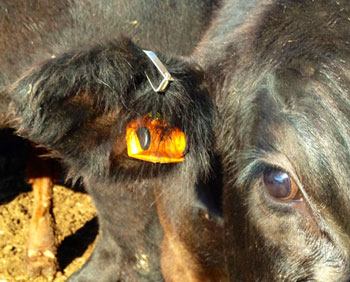
In one recent study, Orsel used a tag containing an
accelerometer
(Ak-sel-er-OM-eh-tur). It measures changes in movement in various directions. This can point to whether a cow is eating, sleeping or jogging across a pasture. Like people, cattle often eat less when they feel sick. So data from this ear tag can show if a cow has changed her feeding habits and might be ill.
For several years, these ear tags have been working well on dairy farms. But the devices have been proving less accurate for beef cattle. There were lots of false positives. Explains Orsel, “We would get notification that there are more animals sick than there truly are.”
The problem, Orsel learned, is that beef cattle spend their days differently. Dairy cows, for instance, spend lots of time standing still as they’re milked and often eat in a barn. Steers, however, tend to meander as they graze. And ranchers may move them from one pasture to another every few days.
Still, Orsel thinks the ear tags can help even with beef cattle. “The technology will not replace people,” she says. But it could limit how much of a herd a farmer or rancher might need to watch carefully — just the few flagged as possibly sick by ear-tag data. That’s a manageable job.
A better diet for cow and climate
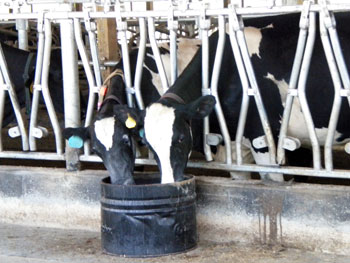
Cows are known for their ability to eat grass — something that would make a human sick. But that’s not all they eat. Most U.S. dairy cows dine on a “total mixed ration,” explains Alex Hristov. He’s an animal scientist at Pennsylvania State University in University Park. These meals, he explains, are a mixture of grains and fiber-rich materials, such as hay or fermented plant material, called silage. The mix also contains protein-rich material from some oilseeds or beans, such as canola or soy. Even some industrial byproducts might be included, such as the grain left over from making alcohol.
Getting the recipe for this ration right is important because if there’s a problem with nutrition, “milk production is going to suffer immediately,” Hristov says.
METHANE MADNESS How do cows produce so much methane? This video explains. E. OTWELL, H. THOMPSON, ORANGE HD, NASA, LISA MCKEOWN/UNIV. OF ALBERTA, GRIEG/CZECH NAT’L SYMPHONY, DOCTOR TURTLE, AQUA CHANNEL |
He and others have been working to lower the cost of a cow’s feed and to boost its nutrition. That way, a farmer will pay less to fuel his herd’s production of milk. “Anywhere from 40 to 60 percent of all the expenses on a dairy farm are for feed,” Hristov notes. Any savings here will help farmers greatly.
But there’s another worry — one that goes well beyond the farm. Cows burp out methane, a greenhouse gas.
Cows have a complex stomach, and its biggest compartment is the rumen. It can weigh up to 120 kilograms (260 pounds). Inside the rumen, microbes break fiber down into nutrients that a cow can use. This process releases gases, including methane. “If the cows don’t burp it out, they will bloat and die,” Hristov notes.
About one-quarter of all methane emissions in the United States come from livestock. That’s according to the U.S. Environmental Protection Agency. Reducing methane from cow burps could help limit global warming and its impacts.
How? Hristov’s new data show that changing a cow’s feed can help.
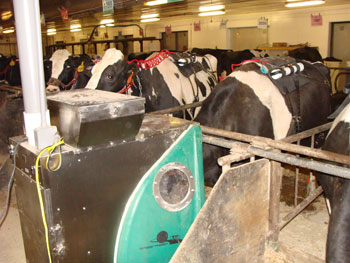
His team has been working with a chemical known as 3-nitrooxypropanol (NI-troh-OX-ee-PRO-pah-nawl), or 3NOP. Adding it to feed can cut methane burps from dairy cows by about 30 percent. Cows eating feed with this additive for 12 weeks also gained more weight than did cows dining on plain rations. Best of all: There was no drop in the amount or quality of milk produced. The researchers just published their findings August 25 in the Proceedings of the National Academy of Sciences.
The 3NOP works by blocking an enzyme needed for the last step in the methane-forming process. That reaction normally bonds hydrogen atoms to carbon atoms in the animals’ diet. It’s still not clear what’s happening with the hydrogen that isn’t tied up this way. Microbes in the rumen might produce less hydrogen as they break down nutrients, Hristov says. Or the bugs might use hydrogen in other ways. Further research should shed light on the mystery.
Cleaning up a mess
Cattle eat a lot — and a lot comes out of them, too. Each day, a 680-kilogram (1,500-pound) dairy cow poops out 57 kilograms (125 pounds) of manure. Finding uses for all of that waste could put extra money in a farmer’s pocket. Managing the wastes better also can help the environment.
Dana Kirk is a biosystems engineer at Michigan State University in East Lansing. “My research mainly focuses on the back end of the cow,” he quips. By this he means that his team is looking for better ways to turn manure into a resource: biogas.
This mixture of gases, including methane, can be burned for energy. Kirk’s lab uses anaerobic, or oxygen-free, digestion to create that biogas. “We’re more or less creating an extension of the cow’s stomach and intestines,” he says.
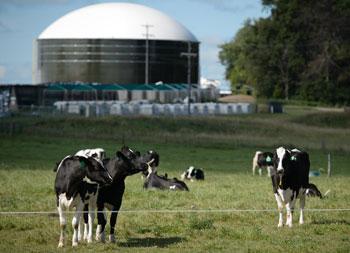
Manure is undigested food. It’s what is left over after a cow has gotten as much nutrition as it can out of its feed. But various microbes can break down the leftovers in manure to get out even more energy. Michigan State engineers are tapping the ability of these germs by mixing manure and other types of food waste with them in a big tank. As these microbes break the wastes down, they release gases that can be harnessed as a fuel.
Burning biogas can produce steam and electricity. If processed further, the methane in biogas can be turned into a fuel for home heating, industrial processes, transportation and more. And, Kirk adds, “It’s renewable.” Instead of taking carbon out of the ground as a fossil fuel, “we’re producing it from waste,” he explains — and a type that is generated daily.
“A large anaerobic digester on the college campus uses cow manure from the school’s dairy farm. Food waste from school cafeterias and the local community provide extra inputs. Biogas from the facility now produces about 400 kilowatts of electricity. That’s enough to power 250 to 300 nearby homes.
Engineers are now looking for better mixes of manure and other wastes to power the system. Doing that might control odors and make the process more efficient. That last feature also could boost the energy output of that digester, all the while lowering the cost of the electricity it creates.
Kirk’s team recently looked at ways to add a solar collector. Heat from the sun can keep a digester operating at the temperature that its microbes like best. That might help them produce more gas for a given input of wastes.
One downside is that the solar collector works only when the sun shines. However, by combining it with the anaerobic digester, some of the sun’s heat energy is transformed into biogas. People later can use that biogas to power the system even when it’s dark or cloudy. Kirk’s team described its idea for this system in the April 1 issue of Energy.
Kirk and others also are scouting better ways to use cow manure as a fertilizer. Controlling odors is one challenge. After all, poop stinks! Some researchers are looking to extract various nutrients, such as phosphorus, nitrogen and potassium. If they also extract much of the water and other unneeded materials, the resulting fertilizer would weigh less. That could cut the cost of transporting the fertilizer. It also could create a higher-quality product — enriched in the nutrients that farmers want most. And that could make the fertilizer worth more money.
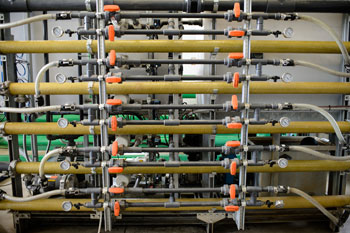
Better processing and handling of fertilizer also can help the environment. For example, too much phosphorus in the rain running off of fields can lead to harmful algal blooms
western Lake Erie. The algae can poison water. Even when that doesn’t happen, the blooms can clog water-treatment plants and upset food webs in lakes, streams — even the ocean.
But here’s an extra bonus for this manure clean-up. It might just yield water clean enough to irrigate dry fields.
Already, a Michigan State test project can pull enough wastes out of the liquid manure to produce water clean enough for a cow to drink! Half of every gallon can end up as water available for livestock or irrigation. The goal is to get that amount up to 65 percent of each gallon of manure. The project, which began a decade ago, is just about ready to go commercial.
Kirk, Hristov and Orsel all love cows. Their work also pays off by helping farmers and ranchers run more sustainable businesses. That way, they can produce nutritious food with fewer impacts on the environment. And the rest of us can continue to bite into juicy burgers and cones of delicious ice cream.
This is one in a series on careers in science, technology, engineering and mathematics made possible with generous support from Alcoa Foundation.
Power Words
(for more about Power Words, click here)
accelerometer An instrument for measuring vibrations or a change in the rate of movement. These sensors typically can measure movement changes in all three dimensions (front-to-back, side-to-side and up-and-down).
algae Single-celled organisms, once considered plants (they aren’t). As aquatic organisms, they grow in water. Like green plants, they depend on sunlight to make their food.
anaerobic digestion The process of breaking down material to produce energy without the presence of oxygen. Anaerobic digestion can take place in organisms. It can also take place in engineered equipment, known as an anaerobic digester.
app Short for application, or a computer program designed for a specific task.
atom The basic unit of a chemical element. Atoms are made up of a dense nucleus that contains positively charged protons and neutrally charged neutrons. The nucleus is orbited by a cloud of negatively charged electrons.
biogas Gas produced by a biological process, which can contain methane, carbon dioxide and other chemicals.
bloom (in microbiology) The rapid and largely uncontrolled growth of a species, such as algae in waterways enriched with nutrients.
bovine Having to do with cattle.
cattle Also known as bovines (because they’re members of the subfamily known as Bovinae), these are breeds of livestock raised as a source of milk and meat. Although the adult females are known as cows and the males as bulls, many people refer to them all, generally, as cows.
chronic A condition, such as an illness (or its symptoms, including pain), that lasts for a long time.
climate The weather conditions prevailing in an area in general or over a long period.
climate change Long-term, significant change in the climate of Earth. It can happen naturally or in response to human activities, including the burning of fossil fuels and clearing of forests.
commercial (in research and economics) An adjective for something that is ready for sale or already being sold.
digest (noun: digestion) To break down food into simple compounds that the body can absorb and use for growth. Some sewage-treatment plants harness microbes to digest — or degrade — wastes so that the breakdown products can be recycled for use elsewhere in the environment.
engineer A person who uses science to solve problems. As a verb, to engineer means to design a device, material or process that will solve some problem or unmet need.
engineering The field of research that uses math and science to solve practical problems.
environment The sum of all of the things that exist around some organism or the process and the condition those things create for that organism or process. Environment may refer to the weather and ecosystem in which some animal lives, or, perhaps, the temperature, humidity and placement of components in some electronics system or product.
Environmental Protection Agency (or EPA) An agency of the federal government charged with helping create a cleaner, safer and healthier environment in the United States. Created on Dec. 2, 1970, it reviews data on the possible toxicity of new chemicals (other than food or drugs, which are regulated by other agencies) before they are approved for sale and use. Where such chemicals may be toxic, it sets rules on how much may be used and where it may be used. It also sets limits on the release of pollution into the air, water or soil.
enzymes Molecules made by living things to speed up chemical reactions.
epidemiologist Like health detectives, these researchers figure out what causes a particular illness and how to limit its spread.
false positive In statistics, a conclusion — based on the data — that a difference exists between two or more conditions being tested, when in fact none exists.
feedlot A facility where beef cattle or other livestock may go after living on farms or ranches and before being slaughtered for food. For three to six months, the animals eat a special diet that helps them gain weight and produce high-quality meat. Feedlots can host hundreds or even thousands of animals at a time.
fermentation The metabolic process of converting carbohydrates (sugars and starches) into short-chain fatty acids, gases or alcohol. Yeast and bacteria are central to the process of fermentation. Fermentation is a process used to liberate nutrients from food in the human gut. It also is an underlying process used to make alcoholic beverages, from wine and beer to stronger spirits.
fertilizer Nitrogen and other plant nutrients added to soil, water or foliage to boost crop growth or to replenish nutrients that removed earlier by plant roots or leaves.
fossil fuel Any fuel — such as coal, petroleum (crude oil) or natural gas — that has developed in the Earth over millions of years from the decayed remains of bacteria, plants or animals.
global warming The gradual increase in the overall temperature of Earth’s atmosphere due to the greenhouse effect. This effect is caused by increased levels of carbon dioxide, chlorofluorocarbons and other gases in the air, many of them released by human activity.
greenhouse gas A gas that contributes to the greenhouse effect by absorbing heat. Carbon dioxide is one example of a greenhouse gas.
greenhouse effect The warming of Earth’s atmosphere due to the buildup of heat-trapping gases, such as carbon dioxide and methane. Scientists refer to these pollutants as greenhouse gases. The greenhouse effect also can occur in smaller environments. For instance, when cars are left in the sun, the incoming sunlight turns to heat, becomes trapped inside and quickly can make the indoor temperature a health risk.
hydrogen The lightest element in the universe. As a gas, it is colorless, odorless and highly flammable. It’s an integral part of many fuels, fats and chemicals that make up living tissues.
methane A hydrocarbon with the chemical formula CH4 (meaning there are four hydrogen atoms bound to one carbon atom). It’s a natural constituent of what’s known as natural gas. It’s also emitted by decomposing plant material in wetlands and is belched out by cows and other ruminant livestock. From a climate perspective, methane is 20 times more potent than carbon dioxide is in trapping heat in Earth’s atmosphere, making it a very important greenhouse gas.
microbe Short for microorganism. A living thing that is too small to see with the unaided eye, including bacteria, some fungi and many other organisms such as amoebas. Most consist of a single cell.
nitrogen A colorless, odorless and nonreactive gaseous element that forms about 78 percent of Earth’s atmosphere. Its scientific symbol is N. Nitrogen is released in the form of nitrogen oxides as fossil fuels burn.
nutrient A vitamin, mineral, fat, carbohydrate or protein needed by organisms to live, and which is extracted through the diet.
parasite An organism that gets benefits from another species, called a host, but doesn’t provide it any benefits. Classic examples of parasites include ticks, fleas and tapeworms.
renewable energy Energy from a source that is not depleted by use, such as hydropower (water), wind power or solar power.
rumen The largest part of a cow or steer’s four-part stomach, where microbes break down fiber into nutrients that the animal can use.
silage Chopped plant material fed to cows or other cud-chewing animals such as sheep. Silage typically includes all portions of the plant that grew aboveground (but no roots).
steer A castrated male bovine raised for meat.
sustainability (adj: sustainable) To use resources in a way that they will continue to be available in the future.
technology The application of scientific knowledge for practical purposes, especially in industry — or the devices, processes and systems that result from those efforts.
tuberculosis A bacterial disease that causes unusual growths in the lungs or other tissues. Untreated, it can kill. The infection usually spreads when a sick individual coughs (or talks, sings or sneezes), spewing germs into the air.
veterinarian A doctor who studies or treats animals (not humans).
veterinary Having to do with animal medicine or health care.
watt A measure of the rate of energy use, flux (or flow) or production. It is equivalent to one joule per second. It describes the rate of energy converted from one form to another — or moved — per unit of time. For instance, a kilowatt is 1,000 watts, and household energy use is typically measured and quantified in terms of kilowatt-hours, or the number of kilowatts used per hour.
Word Find (click here to enlarge for printing)
